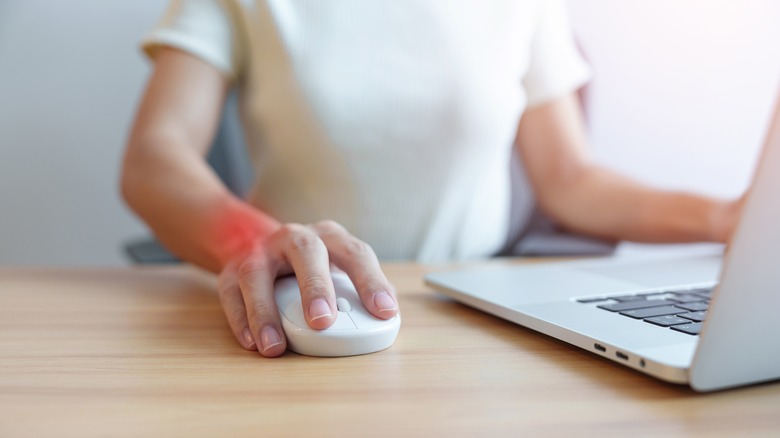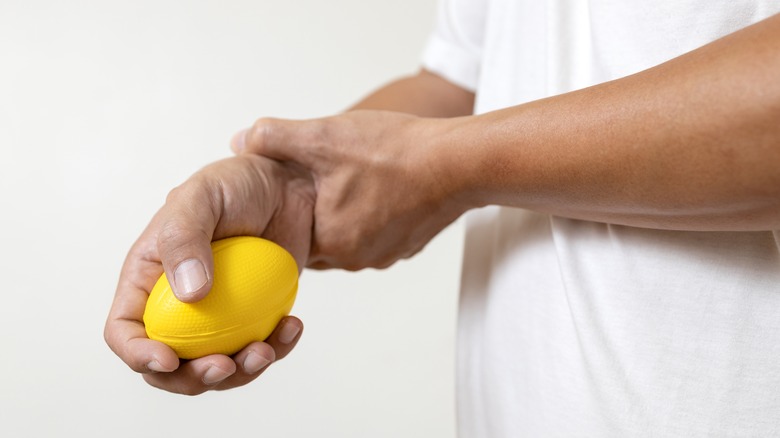Simple Ways To Prevent A Carpal Tunnel Flare-Up
If you've ever seen someone typing while wearing a wrist brace — or if you've worn one yourself — there's a good chance you've come across someone dealing with carpal tunnel syndrome. It has been a fairly common condition for some time and, as more people spend their days at keyboards and working from home, it may become more common yet.
Small repetitive hand movements (such as typing) are only one of the condition's causes, however. According to Johns Hopkins, carpal tunnel syndrome can also be caused by hormonal or metabolic changes, frequent blood sugar changes, or repetitive grasping motions. Even a family history of carpal tunnel syndrome can increase someone's chances of developing the condition. And their chances are three times higher if they were assigned female at birth. If you're experiencing symptoms of carpal tunnel, including numbness or hand pain, it's important to see a doctor for examination and diagnosis.
Diagnosing carpal tunnel
The National Institute of Neurological Disorders and Stroke states that carpal tunnel syndrome cannot be diagnosed without the help of a medical professional, as diagnostic imaging and a few specialized tests are needed. Your doctor will want to be sure that your sympUnfortunately, even once the condition is diagnosed, there is no cure. Carpal tunnel is also a progressive condition, which means that it will inevitably get worse over time. Since the condition won't go away, treatment generally involves managing the symptoms. The right interventions can greatly help ease the discomfort associated with carpal tunnel.
Your doctor may prescribe specific treatments, but not all treatments have to happen in the office. Once the condition is diagnosed, there are several things the patient can do at home to reduce their risk of symptoms flaring. And, as luck would have it, most of them are fairly straightforward lifestyle changes.
What is a flare-up?
Merriam-Webster defines flare-ups as "a sudden appearance or worsening of the symptoms of a disease or condition." When it comes to carpal tunnel syndrome, these symptoms include numbness and tingling (also known as a "pins and needles" sensation) in the fingertips, burning along the center of the wrist, according to Mount Sinai. As the condition progresses, patients can also lose sensation in their hands, up to and including the ability to feel hot and cold.
Mount Sinai adds that, over time, people more severely affected can develop muscle weakness in their hands and wrists. This can lead to a weak grip and, ultimately, a tendency to drop things (despite a person's best efforts not to). People with severe carpal tunnel may also feel as though their hands are swollen, even when they do not appear to be. Mount Sinai suggests this is due to prolonged nerve damage in the area.
Frequent breaks and pain relievers
Preventing flare-ups usually requires the same lifestyle changes that are recommended when someone is first diagnosed with carpal tunnel syndrome. Some of the adjustments recommended by Mayo Clinic, such as avoiding the repetitive motion that caused the syndrome's development, may not be entirely possible. Many people work day in and day out with computers, and many more spend their free time behind keyboards.
A few of Mayo Clinic's other suggestions are applicable to even the most ardent computer user. The Clinic suggests taking short, frequent breaks to rest the wrists. And if the area seems swollen, the Clinic states that ice should be applied to reduce inflammation.
There are also treatment options that do not require a person to change their daytime routine. Some of these changes include taking over-the-counter nonsteroidal anti-inflammatory drugs like ibuprofen, a provider-injected corticosteroid to reduce pain, or a wrist splint that can alleviate wrist strain if worn overnight.
Consider ergonomics
If taking an Aleve for every flare-up doesn't appeal and the thought of regular pain-treating injections is worrying, fear not. Johns Hopkins Medicine offers a few other ways that people can address their carpal tunnel flare-ups.
The first suggestion is to use a wrist splint. Unlike the Mayo Clinic, however, Johns Hopkins does not limit this suggestion to nighttime use. Instead, the suggestion is a general one, as splints keep the wrist in a static position and can reduce pressure on the nerves through the area.
Johns Hopkins also recommends that anyone experiencing carpal tunnel issues should make changes to their workspace. This can include changing to an ergonomic keyboard or other similar ergonomic changes. Mayo Clinic states that common ergonomic recommendations include moving the monitor to be directly at eye level and an arm's length away, adjusting the chair so that a person's hips are in line with their knees, and raising the chair high enough that hands and wrists are either even with or below the elbows.
Strengthening the wrist
Johns Hopkins' final lifestyle recommendation is to strengthen the muscles of the wrist using a variety of exercises. Their website does not outline which exercises to use, but they do say that these strengthening movements may be arranged by a physical therapist.
Mentions of strengthening exercises may call to mind hand weights or cable weight machines. But the American Academy of Orthopaedic Surgeons suggests a different approach when it comes to the wrist. Rather than using weight, their recommendations largely focus on stretching the muscles in the area. The Academy offers a printout of several effective stretches, but they caution against using them without speaking to a medical provider beforehand.
Yale Medicine labels carpal tunnel as the "most common nerve complaint in the U.S." But that does not mean that it is unavoidable — or that, once developed, it cannot be managed. Lifestyle changes, moderate pain management options, and regular breaks can often reduce the impact flare-ups have on people living with carpal tunnel.






